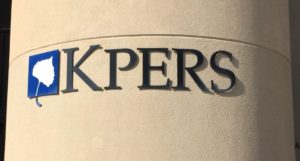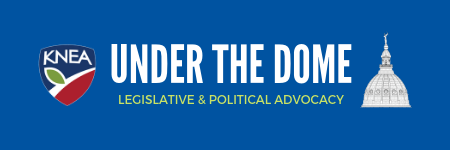Post Highlights
- KPERS officials explain the “what ifs” of Brownback’s irresponsible budget. Short version: DISASTER for KPERS.
- Brownback’s Budget proposal would reduce KPERS contributions by a total of $600 million, extend the time to pay down KPERS’ existing unfunded actuarial liability by 10 years, and add $6.5 billion to the State’s contributions over the long term to pay for it.
- The full breakdown of the effects of Brownback’s proposal on KPERS is included in today’s Under the Dome.
- Brownback’s plan mortgages the future to pay for the $350 million budget hole which remains through the end of this fiscal year.
- There are solid and sensible solutions which take a comprehensive approach to dealing with the Governor’s failed experiment.
- It is important that we all educate ourselves on the nature of the problem and the solutions so that we can encourage our legislators to take the bold steps necessary to achieve long-term results (those solutions are outlined in today’s under the dome and in more detail RIGHT HERE).
- Governor recommends bills for health benefit consolidation.
 KPERS explains the disaster in Brownback’s budget recommendation
KPERS explains the disaster in Brownback’s budget recommendation
The best explanation of the mess that would be created if Governor Brownback’s irresponsible budget recommendations on KPERS were to be enacted was presented to the House Pensions Committee today. We can’t explain it better so here is the document given to the committee this morning:
Governor’s Budget Proposal
$600 Million Shortfall Over Next 3 Years
With the start of the new legislative session, the Governor has announced his budget recommendation for Fiscal Year 17 (current revised), 18 and 19. In short, the proposal would reduce KPERS contributions by a total of $600 million, extend the time to pay down KPERS’ existing unfunded actuarial liability by 10 years, and add $6.5 billion to the State’s contributions over the long term to pay for it. What we don’t pay for now costs more later.
The Breakdown
- In FY 2016, the Sate delayed its fourth quarter payment for State/School employer contributions with a promise to pay it in FY2018 with interest.
Governor’s Recommendation: do not pay
- Governor’s Recommendation: freeze contributions in FY2017, 2018 and 2019 to the reduced amount paid in FY2016.
- Governor’s Recommendation: Pay off the existing unfunded actuarial liability over an additional 10 years.
The Result
- 4 missing State quarterly payments and a total shortfall of $600 million
- Eventual State/School employer contribution rate of 12% to 13% through FY 2045*
- Long-term additional cost of $6.5 billion
- Funded ration stays in the 60% “cautionary” range for an additional eight years or through 2030
- Unfunded liability increases by about $1.3 billion, and it will take 20 years to get back to where we are now
*Doesn’t affect Local employer contribution rates.
Most Important
It’s most important to remember that this does not affect benefits for current retirees, or even for those thinking about retiring. KPERS has $17 billion in assets to pay benefits for many years. The funding shortfall is a long-term funding issue. However, underfunding continues to add to the unfunded liability and undermines KPERS’ long-term strength.
The State’s recent $1 billion pension obligation bond was a significant step in the right direction. But it’s consistent and full employer contributions over time that will make the most difference in having a sound and sustainable retirement system.
What’s Next?
We are at the beginning of the session. And budget legislation will wind its way through the usual process. The Governor’s proposal is a starting point for discussion.
We’ll keep you posted as things affecting KPERS develop in the months to come.
So far the Governor’s proposal is getting a cold reception under the dome. As we reported last week, the K-12 Education Budget Committee has recommended to the full Appropriations Committee that they reject the Governor’s KPERS proposal.
Mortgaging the Future; Cutting the Present; Solving the Problem
You might be wondering what the H-E-double hockey sticks is going on up here in Topeka. You know that there’s a big problem facing Kansas and that problem has been caused by the reckless and irresponsible tax policy proposed by Governor Sam Brownback and passed with great joy by his legislative allies.
That’s true. And here, after four years, Kansans learned the lessons of trickle down economics/tax policy and have thrown many of those responsible out of office, replacing them with new moderate Republicans and Democrats. So this should be the right time to put the brakes on the Brownback disaster and reverse course. It should be easy, you’re thinking.
Oh, that it were so simple!
Brownback issued his “balanced” budget and it’s a doozy! Essentially, Brownback achieves “balance” by mortgaging the future. He robs from the highway plan, he sells off our tobacco settlement money turning this long-term asset into long-term debt, and he steals from KPERS reversing all the hard work done by previous legislatures to stabilize and secure the system.
That’s one way to take care of the issue but let’s take a look at the deeper problem.
First, we are dealing wth three years. Problem one is to find about $350 million to fill the hole in the last six months of fiscal year 2017. The next problem is to solve the revenue decline so as to fix the holes in future budgets – notably fiscal years 2018 and 2019.
Then there is the problem of a Governor who continues to believe his plan is working despite all the evidence to the contrary.
Next, we have a legislature with an enormous number of freshmen, many of whom are just getting their feet on the ground and beginning to understand the process. Remember, we are only 10 days into the 2017 session!
And finally, we are faced with two separate and individual committees in each chamber tasked with the hard work – House Appropriations and Senate Ways and Means that craft budgets (spending) and House Taxation and Senate Assessment and Taxation that craft tax policy (revenue). Somehow, we need to get a revenue plan that corresponds with our budget or spending plan. Not so easily done!
So far – 10 days in – we have only ideas. Okay, we have one bill, HB 2023 that repeals the LLC tax exemption; but really, that’s it.
One idea is the Governor’s: Let’s just mortgage the future, increase the state’s debt, and click our heals while repeating “His tax plan will work, his tax plan will work.”
Another idea is to fix the revenue by reversing the Governor’s policies. The LLC repeal is part of that. The Rise Up plan is another way to do that.
And a third idea – if you don’t like mortgaging the future or reversing the tax cuts – is to cut spending. There is no bill out there proposing that we cut spending.
But things do need to be talked about. And some ideas can be floated to get people thinking about other ideas.
No legislator likes to cut spending or raise revenue (aka raise taxes). And right now there is little interest in mortgaging the future. In order to get people to think that raising revenue needs to be on the table, we have to get them to see what happens if we do not raise that revenue.
This is why leaders will ask what spending cuts look like. Legislators are always reluctant to raise taxes and you can be sure that those who support the Governor will all any reversal of his tax policies an increase. Understanding what the alternative looks like – ruined highways, compromised public safety, stripping seniors and those with disabilities of service, and even cutting public school funding – will help legislators understand the importance of passing a revenue plan that supports vital government functions.
So, it’s early. The new leaders in the House and Senate are not showing support for cutting services more. But the discussion is important. Unless all legislators understand the depth of the problem and the ramifications of taking one path or another, they won’t be ready to make the hard decisions that are yet to come.
Don’t panic yet. But do continue to communicate with your legislators. Let them know that you expect them to deal responsibly with the failed tax policy of Governor Brownback. Make sure all Kansans expect the legislature to reverse course on revenue and support quality state services across the board.
Health Benefit Consolidation, Procurement Bills Introduced
Two bills recommended by the Governor have been introduced. One would enact the consolidated health insurance plan for all school districts while the other would establish a centralized procurement program for school districts.
Both bills were introduced as committee bills in the House K-12 Budget Committee in order to have the discussion on these issues.


